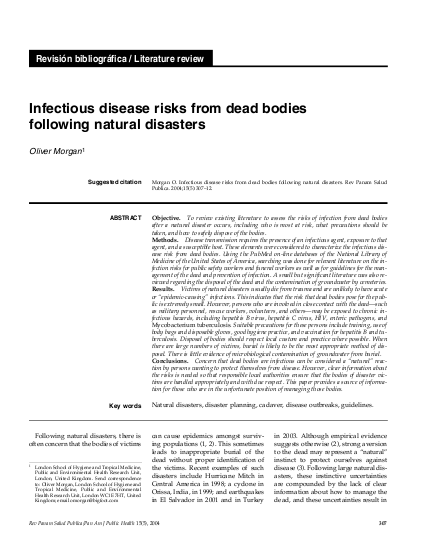
Objective. To review existing literature to assess the risks of infection from dead bodies after a natural disaster occurs, including who is most at risk, what precautions should be taken, and how to safely dispose of the bodies. Methods. Disease transmission requires the presence of an infectious agent, exposure to that agent, and a susceptible host. These elements were considered to characterize the infectious disease risk from dead bodies. Using the PubMed on-line databases of the National Library of Medicine of the United States of America, searching was done for relevant literature on the infection risks for public safety workers and funeral workers as well as for guidelines for the management of the dead and prevention of infection. A small but significant literature was also reviewed regarding the disposal of the dead and the contamination of groundwater by cemeteries. Results. Victims of natural disasters usually die from trauma and are unlikely to have acute or “epidemic-causing” infections. This indicates that the risk that dead bodies pose for the public is extremely small. However, persons who are involved in close contact with the dead—such as military personnel, rescue workers, volunteers, and others—may be exposed to chronic infectious hazards, including hepatitis B virus, hepatitis C virus, HIV, enteric pathogens, and Mycobacterium tuberculosis. Suitable precautions for these persons include training, use of body bags and disposable gloves, good hygiene practice, and vaccination for hepatitis B and tuberculosis. Disposal of bodies should respect local custom and practice where possible. When there are large numbers of victims, burial is likely to be the most appropriate method of disposal. There is little evidence of microbiological contamination of groundwater from burial. Conclusions. Concern that dead bodies are infectious can be considered a “natural” reaction by persons wanting to protect themselves from disease. However, clear information about the risks is needed so that responsible local authorities ensure that the bodies of disaster victims are handled appropriately and with due respect. This paper provides a source of information for those who are in the unfortunate position of managing those bodies.
Resource collections
- UN Habitat - Urban Response Collection
- Urban Response - Urban Crisis Preparedness and Risk Reduction
- Urban Response Collection - Community Engagement and Social Cohesion
- Urban Response Collection - Economic Recovery
- Urban Response Collection - Environment and Climate Change
- Urban Response Collection - Housing, Land and Property
- Urban Response Collection - Urban Crisis Response, Recovery and Reconstruction
- Urban Response Collection - Urban Resilience
